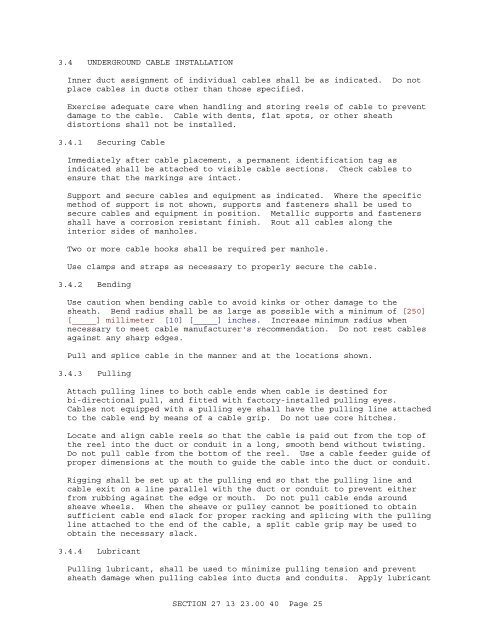UFGS 27 13 23.00 40 Communications Optical Backbone Cabling
UFGS 27 13 23.00 40 Communications Optical Backbone Cabling
UFGS 27 13 23.00 40 Communications Optical Backbone Cabling
You also want an ePaper? Increase the reach of your titles
YUMPU automatically turns print PDFs into web optimized ePapers that Google loves.
3.4 UNDERGROUND CABLE INSTALLATIONInner duct assignment of individual cables shall be as indicated. Do notplace cables in ducts other than those specified.Exercise adequate care when handling and storing reels of cable to preventdamage to the cable. Cable with dents, flat spots, or other sheathdistortions shall not be installed.3.4.1 Securing CableImmediately after cable placement, a permanent identification tag asindicated shall be attached to visible cable sections. Check cables toensure that the markings are intact.Support and secure cables and equipment as indicated. Where the specificmethod of support is not shown, supports and fasteners shall be used tosecure cables and equipment in position. Metallic supports and fastenersshall have a corrosion resistant finish. Rout all cables along theinterior sides of manholes.Two or more cable hooks shall be required per manhole.Use clamps and straps as necessary to properly secure the cable.3.4.2 BendingUse caution when bending cable to avoid kinks or other damage to thesheath. Bend radius shall be as large as possible with a minimum of [250][_____] millimeter [10] [_____] inches. Increase minimum radius whennecessary to meet cable manufacturer's recommendation. Do not rest cablesagainst any sharp edges.Pull and splice cable in the manner and at the locations shown.3.4.3 PullingAttach pulling lines to both cable ends when cable is destined forbi-directional pull, and fitted with factory-installed pulling eyes.Cables not equipped with a pulling eye shall have the pulling line attachedto the cable end by means of a cable grip. Do not use core hitches.Locate and align cable reels so that the cable is paid out from the top ofthe reel into the duct or conduit in a long, smooth bend without twisting.Do not pull cable from the bottom of the reel. Use a cable feeder guide ofproper dimensions at the mouth to guide the cable into the duct or conduit.Rigging shall be set up at the pulling end so that the pulling line andcable exit on a line parallel with the duct or conduit to prevent eitherfrom rubbing against the edge or mouth. Do not pull cable ends aroundsheave wheels. When the sheave or pulley cannot be positioned to obtainsufficient cable end slack for proper racking and splicing with the pullingline attached to the end of the cable, a split cable grip may be used toobtain the necessary slack.3.4.4 LubricantPulling lubricant, shall be used to minimize pulling tension and preventsheath damage when pulling cables into ducts and conduits. Apply lubricantSECTION <strong>27</strong> <strong>13</strong> <strong>23.00</strong> <strong>40</strong> Page 25
















